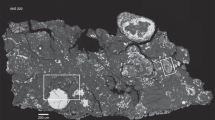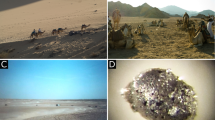Abstract
THE Kakangari meteorite, possibly a unique member of a distinct chemical class of chondrite, fell in India in 1890. Two stones were seen to fall, and though one was soon destroyed the bulk of the other, about 310 g, is preserved in Calcutta and London1,2. Mason and Wiik3 concluded that Kakangari is probably a carbonaceous chondrite. Subsequent improved understanding of chemical fractionation between chondritic groups (see ref. 4) enables us to show, however, that their analysis in fact indicates that Kakangari is similar in bulk composition to the ordinary chondrites, apart from its high S content (Table 1). In this last respect it resembles carbonaceous or enstatite chondrites. The FeO × 100/(FeO + MgO) molecular ratio, 13.7, lies between that of H group (bronzite) chondrites and enstatite chondrites. That is confirmed by our microprobe analyses discussed here. The mineralogical data are based on preliminary microprobe analyses on a thin section cut from a British Museum (Natural History) specimen (BM 69062).
This is a preview of subscription content, access via your institution
Access options
Subscribe to this journal
Receive 51 print issues and online access
$199.00 per year
only $3.90 per issue
Buy this article
- Purchase on Springer Link
- Instant access to full article PDF
Prices may be subject to local taxes which are calculated during checkout
Similar content being viewed by others
References
Nature, 45, 20 (1891).
Hey, M. H., Catalogue of Meteorites, 227, British Museum (Natural History), London, 1966.
Mason, B., and Wiik, H. B., Am. Mus. Novit., 2272, (1966).
Larimer, J. W., and Anders, E., Geochim. cosmochim. Acta, 34, 367 (1970).
Keil, K., and Fredriksson, K., J. geophys. Res., 69, 3487 (1964).
Hutchison, R., and Symes, R. F., Meteoritics, 7, 23 (1972).
Van Schmus, W. R., in Meteorite Research (edit. by Millman, P. M.), 480, (Reidel, Dordrecht, 1969).
Wood, J. A., Icarus, 6, 1 (1967).
Mason, B., and Graham, A. L., Smithsonian Contrib. Earth Sci., 3 (1970).
Keil, K., J. geophys. Res., 73, 6945 (1968).
Keil, K., Earth planet. Sci. Lett., 7, 243 (1969).
Handbook of elemental abundances in meteorites (edit. by Mason, B.), (Gordon and Breach, New York, 1971).
Author information
Authors and Affiliations
Rights and permissions
About this article
Cite this article
GRAHAM, A., HUTCHISON, R. Is Kakangari a unique chondrite?. Nature 251, 128–129 (1974). https://doi.org/10.1038/251128a0
Received:
Issue Date:
DOI: https://doi.org/10.1038/251128a0
This article is cited by
-
Yes, Kakangari is a unique chondrite
Nature (1977)
Comments
By submitting a comment you agree to abide by our Terms and Community Guidelines. If you find something abusive or that does not comply with our terms or guidelines please flag it as inappropriate.



